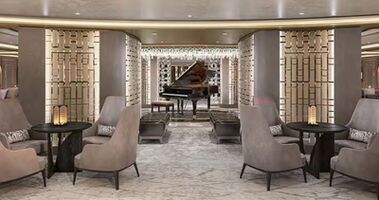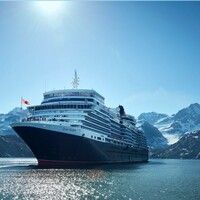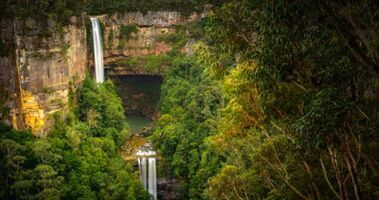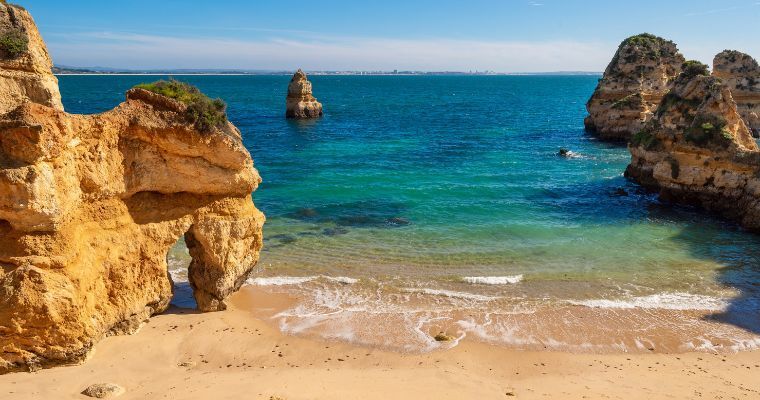
Portugal has long been a destination that beckons travellers with its stunning landscapes, rich culture, and flavoursome cuisine.
Recently, I embarked on a remarkable tour through four of its most captivating regions: Lisbon, Alentejo, the Algarve, and the Portuguese Riviera. I chose to travel with an escorted tour company and experienced a beautifully curated exploration of history, nature, and gastronomy.
Travelling in November provided the added charm of mild winter weather and festive Christmas markets. And it’s not cold! It's one of the best times of the year to travel to Portugal. Why? It's because you’ll miss the crowds, incur lower tour costs and cheaper flights, not to mention that at this time of year the entertainment abounds, especially of the Christmas variety!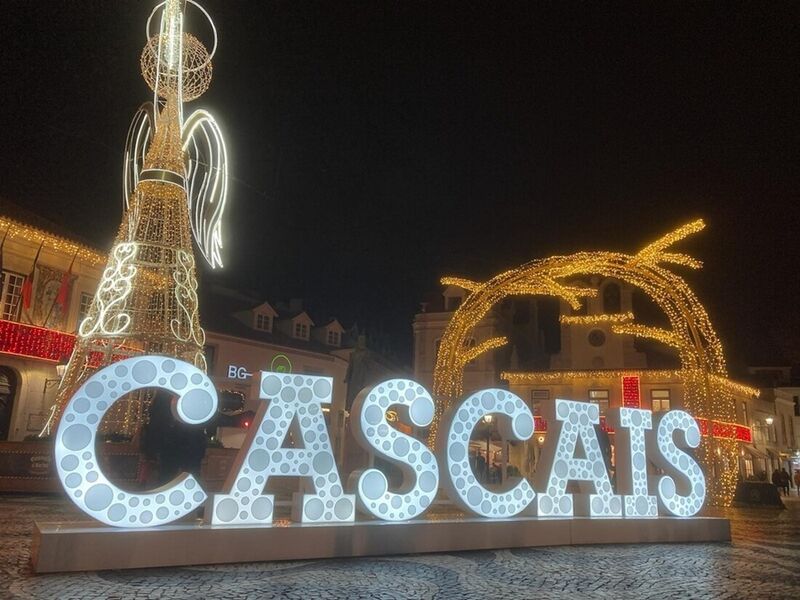 Cascais lights near the Christmas markets. A wonderful time to visit!
Cascais lights near the Christmas markets. A wonderful time to visit!
My warm welcome began in Lisbon, Portugal’s vibrant capital. I must also mention that at the start of this trip, I took an independent day trip to the sanctuary of Fatima on my own with another tour operator. Fátima is one of Portugal’s most important pilgrimage sites. Known for its Sanctuary of Our Lady of Fátima, where the Virgin Mary is said to have appeared to three shepherd children in 1917, Fátima is a place of spiritual significance. I explored the sanctuary, visited the basilicas, and took in the peaceful atmosphere of the site, reflecting on its religious history and the devotion of the many visitors who come here each year. Then to start my Portugal tour, whilst staying at the Turim Marques Hotel, I attended a welcome dinner where I met fellow travellers and our knowledgeable Tour Manager.
Lisbon immediately captivated me with its iconic yellow trams, historic architecture, and cobblestone streets. A walking tour through the city highlighted the traditional Portuguese mosaic sidewalks, followed by visits to landmarks such as the Belem Tower, the Monument to the Discoveries, and the UNESCO-listed Jerónimos Monastery. In the evening, I experienced the hauntingly beautiful sounds of Fado music, a cherished Portuguese tradition.
Discovering Alentejo’s Charm
From Lisbon, we travelled south to Alentejo, a region renowned for its rolling plains and quaint villages. A highlight was a visit to a family-owned cork factory, where Joaquim shared the fascinating process of crafting cork products, from furniture to bow ties. In the UNESCO-listed “Museum City” of Évora, I explored medieval streets, the Roman Temple, and the Chapel of Bones. The day culminated with a traditional Alentejo lunch, accompanied by the harmonious voices of a Cante Alentejano singing group.
The Algarve’s Stunning Coastline
Continuing south, we arrived in the Algarve, known for its sun-drenched beaches and dramatic cliffs. A visit to the Sharish Gin Distillery introduced us to Marisa, who passionately shared her craft of blending traditional methods with local ingredients. At the Herdade do Rocim Winery, Bruno and his team provided an exceptional wine-tasting experience paired with delectable Portuguese Petiscos. In Lagos, I enjoyed leisure time exploring the marina, Praia Dona Ana beach, and the charming town streets. A boat ride along the Algarve’s turquoise waters and rugged cliffs was a definite highlight, showcasing the region’s breathtaking natural beauty.
Monchique and Portimão’s Hidden Treasures
A visit to Portimão included a tour of the Museum of Sardine Canning, housed in a former factory. In Monchique, Pedro guided us through the picturesque village before leading a sourdough bread-making workshop at Alto da Foia, the Algarve’s highest peak. The experience was a sensory delight, featuring freshly baked bread filled with cheese and aromatic herbs, complemented by stunning panoramic views.
Exploring the Portuguese Riviera The statues at Mercado do Livramento fish market
The statues at Mercado do Livramento fish market
From the Algarve, we journeyed to Cascais via Setúbal, where I visited the Mercado do Livramento, one of the world’s finest fish markets. A family-run tile factory in Azeitão offered an engaging demonstration of traditional Portuguese craftsmanship. Cascais, with its blend of historic mansions and scenic ocean views, was a true coastal gem.
Obidos and Sintra’s Timeless Allure
The medieval charm of both Óbidos and Sintra was unforgettable. Wandering through Óbidos felt like stepping back in time, while Sintra offered the choice of exploring the National Palace or strolling through the picturesque village streets. At Cabo da Roca, the westernmost point of continental Europe, I admired the dramatic coastline before concluding the day with a farewell dinner.
Here's a sample of my daily highlights through Portugal
Day 1: Arrival in Lisbon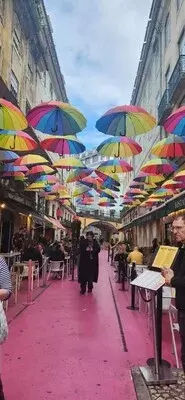 Pink Street, LisbonI arrived in Lisbon; a city were old-world charm blends seamlessly with modern vibrancy. After settling into my hotel, I joined fellow travellers for a welcome dinner. The evening was filled with lively conversation, setting the tone for an exciting adventure.
Pink Street, LisbonI arrived in Lisbon; a city were old-world charm blends seamlessly with modern vibrancy. After settling into my hotel, I joined fellow travellers for a welcome dinner. The evening was filled with lively conversation, setting the tone for an exciting adventure.
Day 2: Exploring Lisbon
The day began with a locally guided walking tour through Lisbon’s cobblestone streets, admiring the intricate Portuguese mosaic sidewalks. I visited the Belem Tower, Monument to the Discoveries, and Jerónimos Monastery, learning about Portugal's rich history. In the evening, I had the option to experience Fado music, the soulful tunes of Portugal. Don’t expect a party here, the Fado is a story to be told through music.
Day 3: Lisbon to Évora
Leaving the city behind, I ventured into Portugal’s countryside to visit a family-owned cork factory. The intricate craftsmanship amazed me. In Évora, I explored St. Francis Church, Diana's Temple, and enjoyed a traditional Alentejo lunch accompanied by beautiful "Cante Alentejano" singing.
Day 4: Évora to Lagos
I travelled to the Algarve region, stopping at a winery for a tour, tasting, and a light lunch. In Lagos, a historic coastal town, I explored its Moorish and Renaissance influences and marvelled at the stunning views from my hotel.
Day 5: Relaxing in Lagos
This was a day for leisure and exploration. I wandered the quaint streets of Lagos, learning about Henry the Navigator’s legacy. A boat tour along the cliffs, with turquoise waters below and dramatic rock formations above, was a highlight of the trip.
 Our boat tour heading out to the amazing cliffs of Lagos
Our boat tour heading out to the amazing cliffs of Lagos
Day 6: Portimão and Monchique
In Portimão, I visited the Portimão Museum, which highlighted the area’s sardine canning history. Later, in Monchique, I savoured fresh Algarve specialties during a picnic and tried "medronho" while admiring the views from Alto da Foia.
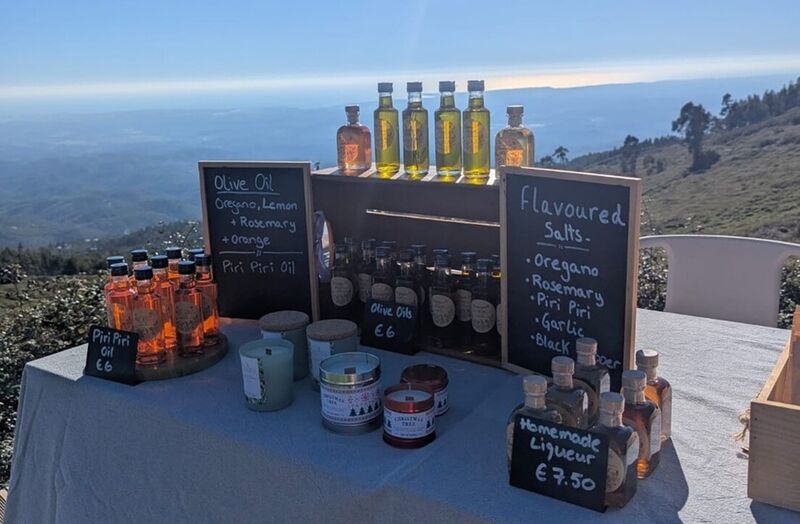 Local produce enjoyed at our picnic at Alto da Foia
Local produce enjoyed at our picnic at Alto da Foia
Day 7: Setúbal to Cascais
The day started with a visit to Setúbal’s Mercado do Livramento, one of the world’s top fish markets. I then toured a family-run tile factory, where I learned the art of creating azulejos. Heading to Cascais, I enjoyed the historic charm of the Portuguese Riviera at Christmas time.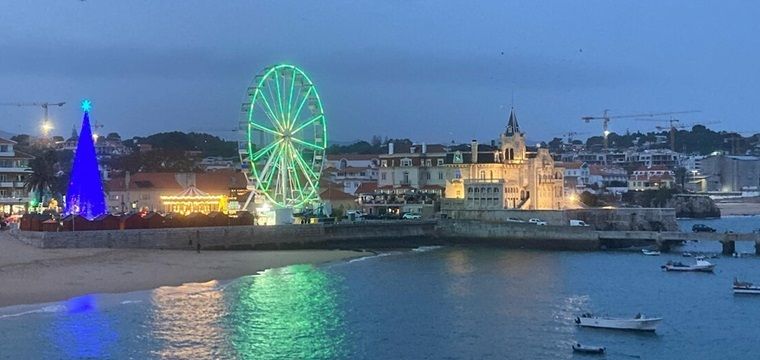 Strolling along the Portugese Riviera in Cascais
Strolling along the Portugese Riviera in Cascais
Day 8: Obidos, Sintra, and Cabo da Roca
The final day took me to the medieval city of Obidos and the UNESCO-listed town of Sintra. I wandered the village streets and visited the westernmost point of Europe, Cabo da Roca, before celebrating with a farewell dinner.
Each day in Portugal offered a new discovery, from cultural treasures to stunning landscapes. The blend of history, art, and gastronomy made this journey truly unforgettable.
Where to Stay
Here's a recap of the hotels that I stayed in. Star ratings for each hotel are based on typical classifications at the time of travel and can change at any time. Some of the rooms at these hotels listed below have a shower over bath, and are NOT IDEAL for those with limited mobility.
- Lisbon - Stayed at TURIM Marquês Hotel (4-star).
- Lisbon to Évora - Stayed at Vila Galé Évora (4-star).
- Évora to Lagos - Stayed at Vila Galé Lagos (4-star).
- Leisure in Lagos - Stayed at Vila Galé Lagos (4-star).
- Portimão and Monchique - Stayed at Vila Galé Lagos (4-star)
The bathrooms at TURIM Marquês Hotel are modern and well-equipped with either a bathtub or shower, along with a hairdryer, toiletries, towels, and bathrobes in some rooms. The hotel is centrally located near landmarks such as Avenida da Liberdade, Eduardo VII Park, and Marquês de Pombal Square.
At Vila Galé Évora, the spacious bathrooms feature marble finishes and offer either a bathtub or shower. Hairdryers, bathrobes, toiletries, and towels are included. The hotel is close to the Roman Temple of Évora, Évora Cathedral, and Giraldo Square. The bathrooms at Vila Galé Lagos are modern, with either a bathtub or shower, and are equipped with a hairdryer, bathrobes, toiletries, and high-quality towels. The hotel is near Lagos Marina, Meia Praia Beach, and Fortress Ponta da Bandeira.
What do the Portuguese Like to Eat?
These are just some of my personal favourites, although there is so much more! These were very popular in most places or cafes I visited. Perhaps on your impending trip to Portugal, you’ll be tempted by the below to experience yourself and even find your own favourites.
- Bacalhau (Salted Codfish)
A national dish, often served in various forms like bacalhau àbrás (shredded cod with eggs and fries) or bacalhau com natas (cod in cream sauce). - Pastéis de Nata
These famous custard tarts, particularly popular in Lisbon, are a sweet treat often enjoyed with coffee. The original pastéis de nata, or Portuguese custard tarts, are said to have originated at Pastéis de Belém in Lisbon. This iconic pastry shop has been making these tarts since 1837, and they remain the gold standard for custard-filled treats. Pastéis de Belém is located near the Jerónimos Monastery in the Belém district of Lisbon. The tarts here are legendary for their crispy, flaky pastry and creamy, slightly caramelized custard filling. Though you can find pastéis de nata throughout Portugal, the ones from Pastéis de Belém, they are particularly renowned for their authenticity and rich history. If you are in Lisbon, it is worth a visit to taste the original! - Caldo Verde
A comforting green soup made with kale, potatoes, chorizo, and olive oil, especially common in the Alentejo region. - Açorda de Marisco
A seafood bread soup with garlic, coriander, and olive oil, a dish often enjoyed in the Algarve. - Cataplana de Mariscos
A seafood stew typically served in a copper pot (cataplana), a dish from the Algarve region. - Sardinhas Assadas
Grilled sardines, particularly popular in coastal areas like Lisbon and Lagos, often served with roasted peppers and bread. - Chouriço
A spicy Portuguese sausage, often grilled or used in stews, common in the Alentejo region. - Bifana
A popular Portuguese sandwich made with marinated, spicy pork served in a crusty roll. It is commonly enjoyed as a quick, flavorful snack, especially in Lisbon and around the Alentejo. Prego is another beloved sandwich, usually made with a tender beef steak, garlic, and sometimes mustard or chili sauce. It is often served in a roll and can be found at many cafes and casual eateries. The price was $4 to $6 AUD. - Portuguese coffee culture is rich, with bica (like espresso) being the most common choice. Coffee is often enjoyed with a sweet pastry like pastéis de nata or torrada (buttered toast), especially in the morning. Average coffee cost was around about $2.50 to $4 AUD and was amongst the best coffee I’ve tasted in Europe so far… (Italians are good at it, but the Portuguese do it better!) Yes, I know it sounds like the old 80’s t-shirt statement here. For those who were unborn, just google it!
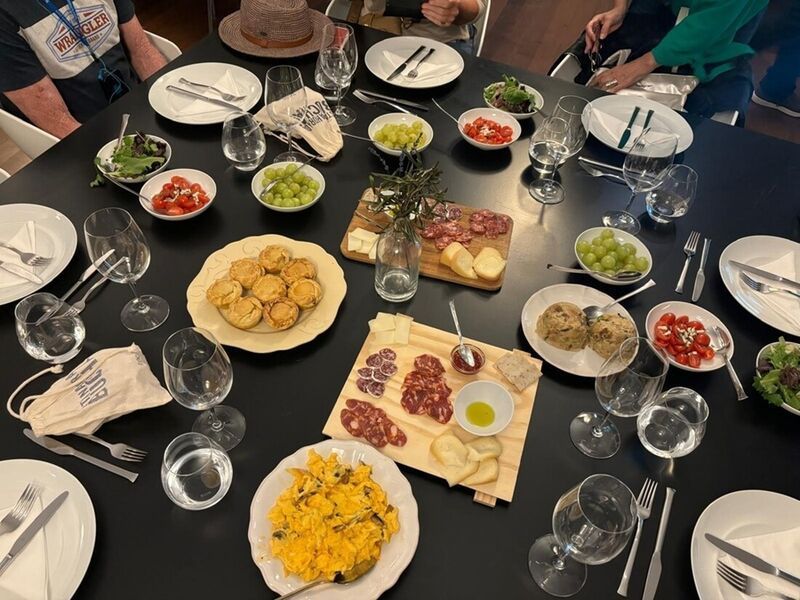 A delicious lunch at a winery stop in the Algarve region
A delicious lunch at a winery stop in the Algarve region
What you need to know about tiles and cobblestones
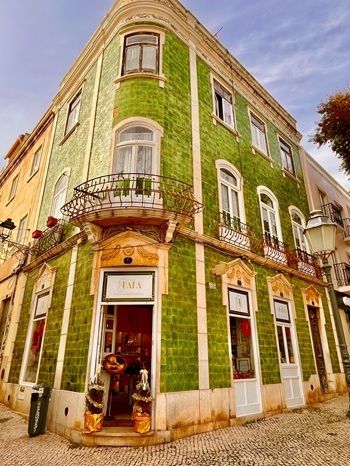 Beautiful azulejos adorns this corner store not far from the Henry the Navigator statue in LagosPortugal is known for its beautiful azulejos, which are colourful ceramic tiles used to decorate buildings, walls, and floors. They often have blue-and-white patterns and show pictures of historical, cultural, and religious scenes. You will see them in places like churches, public buildings, and homes in cities such as Lisbon and Évora. In cities like Lisbon and Évora, you will find calçada Portuguese, which are decorative cobblestones arranged in black-and-white patterns. These stones often form designs like waves or geometric shapes. While they look charming, the cobblestones can be slippery, especially in wet weather, so be careful when walking! Avoid heels and shoes with no grip at all costs!
Beautiful azulejos adorns this corner store not far from the Henry the Navigator statue in LagosPortugal is known for its beautiful azulejos, which are colourful ceramic tiles used to decorate buildings, walls, and floors. They often have blue-and-white patterns and show pictures of historical, cultural, and religious scenes. You will see them in places like churches, public buildings, and homes in cities such as Lisbon and Évora. In cities like Lisbon and Évora, you will find calçada Portuguese, which are decorative cobblestones arranged in black-and-white patterns. These stones often form designs like waves or geometric shapes. While they look charming, the cobblestones can be slippery, especially in wet weather, so be careful when walking! Avoid heels and shoes with no grip at all costs!
Portugal’s terrain varies across the country. Lisbon is quite hilly, which can be tough for those with mobility issues. The Alentejo region is flat, whilst the Algarve has rolling hills and coastal cliffs. Northern Portugal and the Douro Valley feature steep river valleys, and the Serra da Estrela mountains are also challenging. Some areas are easier to navigate than others, depending on your mobility.
How did I get there?
I travelled with British Airways and TAP (Portugal Air) and had a wonderful experience with both service levels and also the generous luggage allowance that British Airways offers. Especially after I had done perhaps a bit of extreme shopping in Portugal!
From Lisbon’s lively streets to the tranquil beauty of the Algarve and the elegance of the Portuguese Riviera, this journey was a celebration of history, culture, cuisine, and natural beauty. Along the way, I encountered incredible individuals like Joaquim at the cork factory, Marisa at the gin distillery, and Alexandre at the tile workshop, each adding depth to the experience.
The mild winter weather and festive Christmas markets added an extra layer of charm to an already spectacular destination. Portugal truly is a hidden gem waiting to be discovered. For anyone considering exploring Portugal, this tour offers something for everyone—history buffs, food and wine enthusiasts, nature lovers, and art aficionados.
This unforgettable journey was organised by an escorted touring partner I frequently trust with my clients, whose expertise ensured a seamless and enriching experience. Their carefully curated tours extend far beyond Portugal, offering countless opportunities to explore the world’s most captivating destinations. Portugal is Europe’s underdog, but it packs a lot of punch with so much to see and do! The choices were endless, the people were friendly, and you will get value for your Australian dollar. $10 - $20 went a long way with many tasty meals. Examples are the average cost of 1 kilo of prawns, which was approximately $15 AUD! Coffee, on average, ranges from $2.50-$4 AUD, and Portugal does have some of the best coffee!
Want to join me in Portugal in 2027?
Get in touch to join my group as we explore Portugal together.
Oh, and I must add, the day I arrived, I also had myself pre-booked into a Portuguese cooking class! So, if you want to learn how to make those famous Portugese tarts and more, then do get in touch with me!


